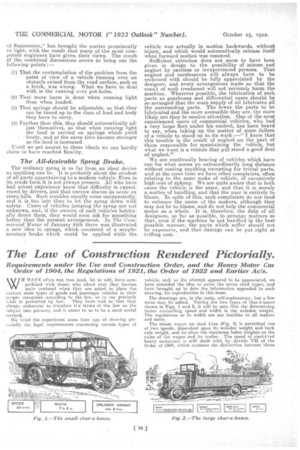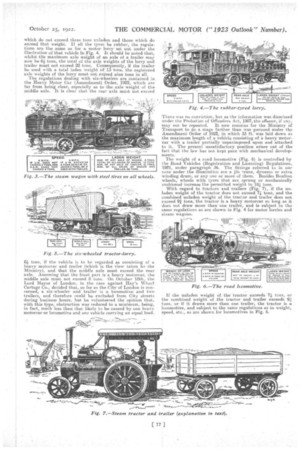The Law of Construction Rendered Pictorially.
Page 6

Page 7

If you've noticed an error in this article please click here to report it so we can fix it.
Requirements under the Use and Construction Order, and the Heavy Motor Cat Order of 1904, the Regulations of 1921, the Order of 1922 and Earlier Acs.
WE HAVE often met men (and, let us add, have s_ympathized with them) who admit that they become quite eonf used when they are asked to place the 1 ariors main types of goods and passenger vehicles in their proper categories according to the law, or to say precisely
what is permitted by law. They have told us that they alway: endeavour to translate tl e terms of the law an the subj.s...ct into pictures, and it seems to us to be a most useful so ethod,, We 'tried the experiment some time ago of showing pie-, torially the legal requirements concerning certain types of
vehicle, and, as the attempt appeared to be appreciated, we have extended the idea to cover the •seven chief types, and have brought up to date the information appended to each drawing, for reproduction in ibis issue.
The drawings are, in the main, self-explanatory, but a few notes may be added. Taking the two types of char-a-banes shown in Figs. 1 and 2, it will be seen that the determining factor controlling speed and width is the unladen weight. The regulations as to width are not familiar to all makers and users.
The steam wagon on steel tires (fig. 3) is permitted one of two speeds, dependent upon its unladen weight and back axle weight, and we show the maximum laden weights on the axles of the wagon and its trailer. The speed of steebtire4d heavy motorcars is still dealt with by Article VII of the Order of 1904, which contains the distinction between those
which do not exceed three tons unladen and those which do exceed that weight. If all the tyres be rubber, the regulations are the same as for a motor lorry set out under the illustration of that vehicle in Fig. 4. It should be noted that, whilst the maximum axle weight of an axle of a trailer may now be 4 tons, the total of the axle weights of the lorry and trailer Must not exceed 22 tons. Consequently, if the trailer be used with a total laden weight of 13 tons, the registered axle weights of the lorry must not exceed nine tons in all.
The regulations dealing with six-wheelers are contained in. the Heavy Motor Car (Amendment) Order, 1922, which are far from being clear, especially as to the axle weight of the middle axle. It is clear that the rear axle must not exceed
4 tons, if the vehicle is to be regarded as consisting of a heavy motorcar and trailer (which is the view taken by the Ministry), and that the middle axle must exceed the rear axle. Assuming that the front part is a heavy motorcar, the middle axle must not exceed a tons. On October 18th, the Lord Mayor of London, in the case against Hay's Wharf Cartage Co., decided that, so far as the City of London is concerned, a six-vdieeler and trailer is -a locomotive and two trailers, and therefore could be excluded from City streets during business hours, but he volunteered the opinion that, with this type, obstruction was reduced to a minimum, being, in fact, much less than that likely to be caused-by one heavy motorcar or locomotive and one vehicle carrying an equal load. There was no conviction, but as the information was dismissed under the Probation of Offenders Act, 1997; the offence, if any, may not be repeated. It now remains for the Ministry of Transport to go a stage farther tha.n was pursued under tke Amendment Order of 1922, in which 33 ft. was laid down as the maximum length of a vehicle consisting of a heavy motorcar with a trailer partially -superimposed upon and attached to it. The present unsatisfactory position arises out of the fact that the law has not kept pace with mechanical developments.
The weight of a road locomotive (Fig. 6) is controlled by the Road Vehicles (Registration and Licensing) Regulations, 1921, under paragraph 36. The fittings referred to in our note under the illustration are a jib -.Tarte, dynamo or extra winding drum, or any one or inure of them. Besides Boulton wheels, wheels with tyres that are sprung or mechanically cushioned increase the permitted weight to 18 tons.
With regard to tractors and trailers (Fig. 7), if the unladen weight of the tractor does not exceed 7A: tont, and the combined unladen weight of the tractor and trailer does not exceed sg tons, the tractor is a heavy motorcar so long as it does not draw more than one trailer, and is subject to the Mine regulations as are shown in Fig. 4 for motor lorries and steam wagons.
If the unladen weight of, the tractor exceeds 7. tons, or Use combined weight of the tractor and trailer exceeds 97 tons, or if it draws more than one trailer, the tractor is a locomotive, and subject to the same regulations as to weight, speed..ete., as are shown for locomotives in Fig. 6.






















































